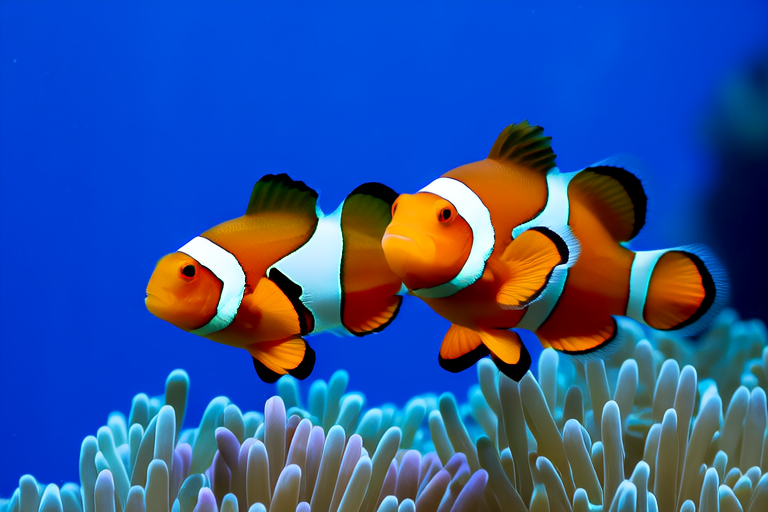Clownfish Companionship: Pairing Tips for Happy Aquarium Life
Introduction
Welcome to the vibrant world of clownfish! These colorful and charismatic marine creatures are beloved by aquarists worldwide. Known for their striking appearance and unique social behaviors, clownfish are not only visually appealing but also fascinating companions in your home aquarium. This article will guide you through the intricacies of creating a harmonious aquarium environment for your clownfish, focusing on pairing tips that ensure happy and healthy lives for these delightful fish.
The Unique Social Behaviors and Natural Habitats of Clownfish
Clownfish are best known for their symbiotic relationship with sea anemones in their natural habitat. They live among the tentacles of anemones, which provide protection from predators. In return, clownfish offer the anemone nutrients from their waste and attract prey. Their behavior within this relationship is complex and intriguing, as they exhibit a hierarchical structure where the largest female is dominant. When the dominant female dies, the largest male transitions into a female to maintain the reproductive pair.
In the wild, clownfish inhabit coral reefs in tropical waters, primarily found in the Indo-Pacific region. Their vibrant colors, typically ranging from orange to black, serve as a warning to potential predators about their toxicity. This toxicity is derived from their diet of algae and small organisms, which contain the same toxins found in sea anemones.
Importance of Tank Size, Water Conditions, and Filtration Systems
To create a thriving environment for your clownfish, it’s crucial to consider the tank size, water quality, and filtration systems. A minimum tank size of 30 gallons is recommended for a single clownfish, with additional space required for each additional fish. Larger tanks allow for more swimming room and reduce the likelihood of stress-related health issues.
Water conditions must be carefully maintained. Clownfish thrive in saltwater environments with a temperature range of 76°F to 82°F (24°C to 28°C). The pH level should be kept between 8.1 and 8.4, and salinity should be around 1.020 to 1.025 specific gravity. Regular testing and adjustment of these parameters are essential for the health of your clownfish.
Filtration systems play a vital role in maintaining water quality. Choose a filter that can handle at least four times the volume of your tank per hour. Biological filtration helps break down harmful ammonia and nitrite, while mechanical and chemical filtration remove debris and excess nutrients. Proper filtration ensures clean and oxygen-rich water, which is crucial for the well-being of your clownfish.
Selecting Compatible Tank Mates
When choosing tank mates for your clownfish, it’s important to consider several factors:
- Temperament: Clownfish are generally peaceful and can coexist with other non-aggressive species. However, they may become territorial if overcrowded or stressed. Avoid aggressive or highly competitive species that could bully or intimidate your clownfish.
- Size: Clownfish vary in size, but most adult clownfish reach lengths of 2 to 4 inches. Ensure that any tank mates are of similar size to prevent dominance issues. Larger fish can outcompete clownfish for food and territory.
- Dietary Needs: Clownfish are omnivorous, feeding on algae, small invertebrates, and zooplankton. Select tank mates with similar dietary requirements to avoid competition for resources. Fish that primarily feed on plant matter or require specialized diets may not be suitable companions.
Some compatible tank mates include other peaceful species such as damsels, wrasses, and tangs. However, always research each species thoroughly to ensure compatibility before introducing them to your aquarium.
Introducing New Fish to the Aquarium
Introducing new fish to your aquarium requires careful planning to minimize stress and ensure a smooth transition. Begin by quarantining new fish in a separate tank for at least two weeks to monitor their health and acclimate them to the water conditions. During this time, observe their behavior and appetite to ensure they are healthy and adapting well.
Once quarantine is complete, introduce the new fish to the main aquarium gradually. Use a drip acclimation method, slowly adding small amounts of aquarium water to the quarantine tank over an hour. This process allows the fish to adjust to the water parameters of the main tank without experiencing shock.
Monitor the new fish closely during the first few days after introduction. Observe their interactions with existing tank mates and watch for signs of aggression or stress. If any issues arise, consider separating the fish temporarily until tensions subside.
General Care Tips for Clownfish
Regular monitoring and maintenance are key to ensuring a thriving aquarium ecosystem. Here are some essential care tips for your clownfish:
- Feeding: Feed your clownfish a balanced diet consisting of high-quality flake or pellet food, supplemented with frozen or live foods like brine shrimp and mysis shrimp. Feed them twice daily, offering only what they can consume within a few minutes to prevent overfeeding.
- Water Changes: Perform weekly water changes of 10-20% to maintain water quality. This removes accumulated waste and replenishes essential minerals. Always use a dechlorinator to treat tap water before adding it to the aquarium.
- Observation
- Health: Regularly observe your clownfish for any signs of illness, such as lethargy, loss of appetite, or unusual spots or growths. Early detection and treatment of health issues can prevent complications and improve recovery chances.
- Decorations and Hiding Spots: Provide ample hiding spots and decorations in the aquarium to mimic their natural environment. This helps reduce stress and promotes a sense of security for your clownfish. Consider incorporating live rock, caves, and plants to create a diverse and enriching habitat.
By following these guidelines, you’ll be well on your way to creating a thriving and harmonious aquarium environment for your clownfish and their companions. Remember, a well-maintained and thoughtfully planned aquarium not only benefits the health of your fish but also enhances the beauty and enjoyment of your aquatic hobby.
Happy fishkeeping!
